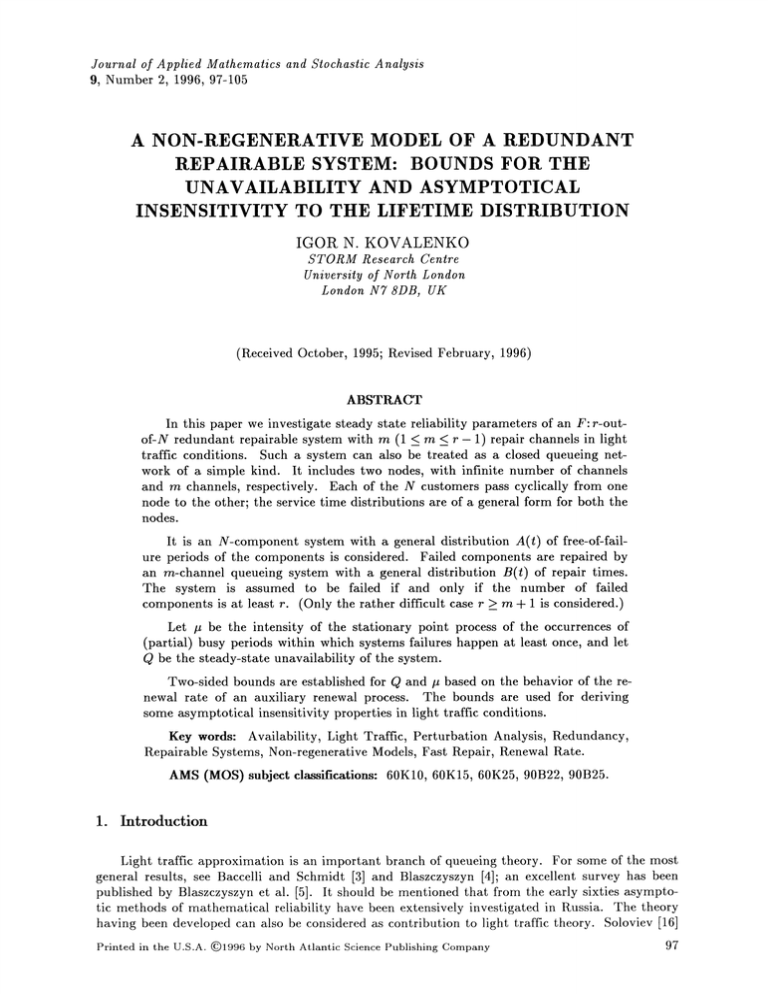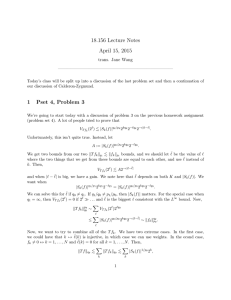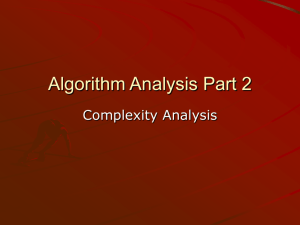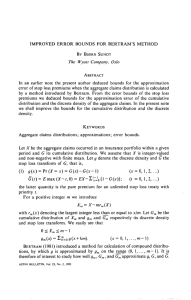A REPAIRABLE THE LIFETIME NON-REGENERATIVE
advertisement

Journal of Applied Mathematics and Stochastic Analysis
9, Number 2, 1996, 9%105
A NON-REGENERATIVE MODEL OF A REDUNDANT
REPAIRABLE SYSTEM: BOUNDS FOR THE
UNAVAILABILITY AND ASYMPTOTICAL
INSENSITIVITY ,TO THE LIFETIME DISTRIBUTION
IGOR N. KOVALENKO
STORM Research Centre
University of North London
London N7 8DB, UK
(Received October, 1995; Revised February, 1996)
ABSTRACT
In this paper we investigate steady state reliability parameters of an F: r-outof-N redundant repairable system with m (1 _< m _< r- 1) repair channels in light
traffic conditions. Such a system can also be treated as a closed queueing network of a simple kind. It includes two nodes, with infinite number of channels
and m channels, respectively. Each of the N customers pass cyclically from one
node to the other; the service time distributions are of a general form for both the
nodes.
It is an N-component system with a general distribution A(t) of free-of-failure periods of the components is considered. Failed components are repaired by
an m-channel queueing system with a general distribution B(t) of repair times.
The system is assumed to be failed if and only if the number of failed
components is at least r. (Only the rather difficult case r >_ rn + 1 is considered.)
Let # be the intensity of the stationary point process of the occurrences of
(partial) busy periods within which systems failures happen at least once, and let
Q be the steady-state unavailability of the system.
Two-sided bounds are established for Q and # based on the behavior of the renewal rate of an auxiliary renewal process. The bounds are used for deriving
some asymptotical insensitivity properties in light traffic conditions.
Key words: Availability, Light Traffic, Perturbation Analysis, Redundancy,
Repairable Systems, Non-regenerative Models, Fast Repair, Renewal Rate.
AMS (MOS)subject classifications: 60K10, 60K15, 60K25, 90B22, 90B25.
1. Introduction
Light traffic approximation is an important branch of queueing theory. For some of the most
general results, see Baccelli and Schmidt [3] and Blaszczyszyn [4]; an excellent survey has been
published by Blaszczyszyn et al. [5]. It should be mentioned that from the early sixties asymptotic methods of mathematical reliability have been extensively investigated in Russia. The theory
having been developed can also be considered as contribution to light traffic theory. Soloviev [16]
Printed in the U.S.A.
(C)1996 by North
Atlantic Science Publishing Company
97
IGOR N. KOVALENKO
98
is the work of the most fruitful subsequent theory. Por a recent presentation of the approach, see
Soloviev [17] and Gertsbakh [6]. In an early paper by Kovalenko [9] a small parameter approach
complex system. For further results see
Kovalenko [10-12], Pechinkin [14], Stadje [18], and Zazanis [19]. A small parameter approach was
used for deriving variance reduction methods of the simulation of rare events; see Reiman and
Weiss [15], Asmussen [1], Heidelberger et al. [8], Kovalenko and Kuznetsov [13], and Gnedenko
and Kovalenko [7].
was
suggested for the analysis of the availability of
a
In this paper we investigate the behavior of a closed queue in light traffic conditions. The
Markov process describing its behavior contains m supplementary variables and thus cannot be reduced to a semi-Markov model. On the other hand, no parametric model (such as thinning or 7dilation) is assumed. An interesting property is observed in the case of a closed queueing system:
some parameters of the system are asymptotically (as traffic intensity p-0) insensitive to the distribution of free-of-failure time; only the mean free-of-failure time period is essential. A contrast
can be observed in this point to open queues; see Atkinson [2].
2. System Description
Consider a system consisting of N machines subject to random failures and repaired by rn
repair channels. Usual i.i.d, and FIFO conditions are assumed to be satisfied. The following functions and parameters will be considered throughout the paper:
A(t) -d.f.
B(t)
(z)
h(t)
of a component’s free-of-failure time:
d.f. of repair time:
f
B(x)dx;
f eztdB(t);
----
renewal rate of a renewal process formed by points 0, 0 + ri0 + 1, 0 rl0
(2,..-, where i and rii are totally independent and distributed according to
B(t);
hu(t
(t)- 1 B(t), B(t)
(t)- 1- A(t), 4(t)- f A(x)dx;
-sup h(x),
x>t
hL(t
-=lfth(x), ,
hu(O), A- N..
1
ri1
i A(t),
The time scale is assumed to be chosen in such a way that
/
tdB(t)-p,
0
The following Markov process
/
tdA(t)-l-p; O<p< 1.
0
((t)
will be considered for describing the system’s behavior:
(t)
(i(t), rii(t), 1 <_ <_ N),
where i(t) is the residual time to failure of machine if it is operating at time t; i(t) is not defined otherwise; rii(t) is the residual repair time of machine if it is being repaired; rii(t) is not
defined otherwise. [Thus, neither i(t) nor rii(t)is defined for a queueing machine.]
In what follows it is assumed that the process (t) and some point processes connected to it
that are required for our purposes are stationary. Our aim consists of the derivation of upper and
lower bounds for the following parameters:
# -intensity of (partial) busy periods within which the queue length u(t) achieves a fixed level
r at least once (rn + 1 _< r _< N);
A Non-Regenerative Model of a Redundant Repairable System
99
Q steady state probability of the event {u(t) >_ r}, i.e., the unavailability of the system.
Both the upper and the lower bounds are obtained by a straightforward renewal argument.
The following properties are used: a compactness property of the process (t) yielding some
bounds for (0), analysis of busy periods in a time interval (0, T), analysis of a virtual busy
period starting at time T, and analysis of the renewal probability of all machines in the interval
(0, T). Essentially, the local independence of alternating renewal behaviors of machines as soon as
u(t) < m is used.
3. Upper Bounds
3.1 Ergodic bounds
The following inequalities hold true:
P{i(0) dx} <_ A(x)dx, P{r/i(0) dx} <_ B(x)dx.
(1)
P{{i(O) >_ x} _< A(x), P{r/i(O)_> x} _< B(x),
(2)
P{u(O) >_ 1} _< Np.
(3)
In particular,
and
3.2 Upper bounds for the factorial moment intensity
For
a fixed
T > 0, machine called T-renewed if i(0) < T
or if
i(0)
is not defined. Denote
h (Zl,...,Xs_l)5 +o( s) the probability of such an event" {all the machines are Trenewed; some different machines fail during time intervals (T, T + 6), (T + Xl, T + x + ), (T +
s
by
I
x2, T-x2-t-5),...,(T+Xs_l,T+xs_ 1-t-5), 0< x I <...< Xs_l,
5--0}.
Consider the expressions
tIS)
N[S])d(z)((1 -(A(z)(2Nz)/z))-lexp{ Am + 1T99m(z)/(zm
Azm
19(z)) }
1 ’4)k
where
0(z)-(1 +1/2N2z"(Nz)) pN(z),
(5)
provided z and z 0 are positive and the denominators are positive as well, and
"(0s,
N[S](hb(T- TO)-4- S(N4(To- A)-4- N2 fl4(To- A)-t- ZlA0(z0))).
e
(6)
Then the following upper bound holds true:
h)(*l,""Xs-1)
Us) + Us)
for every positive z, z i; the denominators are positive as well.
We also have
(7)
IGOR N. KOVALENKO
100
h)(...) <_ (H) + 1)N[S]A <_ (H) + 1)A s.
s
3.3 Upper bound for tt
We have
#
where
-
(9)
#0 +/11 ///2,
(r-l) ,(H(Or)+ ur))flr-1
1
1
+
!(__1!
(8)
if r--m+1,
(o)
f0
ifr>_m+2,
x
#I(H0) + 1)A + l(2(z)/z)r,
r
#2-
NA(T).
(11)
(12)
3.4 Upper bound Q
We have
Q -< Qo +Q1 +Q: +Qa,
(13)
where
Qo
m!(r
+. Hr))/
-m-ll ),(H(or)
xr--m-- lm(x)dx,
(14)
0
QI
(r / 1)(H0) / 1)(A/z) r + l(2(z))r/2,
(15)
N4(T)(H0) /
2N(T)(H) + 1)AN + l(z)/(Z23)’
(16)
Q2
Q3
(17)
with
2A(z)/z,
(18)
> 0, 2Ap(z) < z.
(19)
1
z
4. Lower Bounds
4.1 Lower bound for the joint p.d.f.
For 0 < x I <
< x r + 1, denote by f(xl,...,Xr_ 1)5r+ o(5 r) the (T-independent) probability
for some il,...,ir;
{u(T)-0;
r_l <i <xr-l/5
i( T)>xr-lfralltheri}" Then we have, for <A<T 0:T,
of
the
event
0<il(T)<5,..g,x
f(xl,...,Xr_l) >_ N[r](1-e)(Co-ClXr_l),
(20)
A Non-Regenerative Model of a Redundant Repairable System
101
where
N(p(1 + 1/A) + A (T O A)),
e
(21)
Co-hrL(r-To)-)r+l((N2-r)p+NA+(N)(N-m)r(zp) rn)
m
Cl
Nr + 1.
(22)
(23)
4.2 Lower bounds for p
We have
#
>_ N[r](1 e)(coi0 c111)
(24)
where
1
I0
(r-1
1
f
m!(r_m_2)"0
),.pr-1
X
r-m-
if r
rn
+ 1,
(25)
2[m(x)dx
I1 (m- 2)!(r- m + 2)!(r- m)
if r
> m + 2,
xr-m + 2dB(x)"
(26)
0
4.3 Lower bound for Q
We have
Q >_
N[r](1
e)(CoJ o ClJ1)
(27)
f
(28)
where
Jo m!(r- 1m- 1)! xr-m-lm(x)dx
0
J (m- 2)!(r- m)!(r-1 rn + 2)(r- rn + 3) pm
2
/ xr
m
+ 3dB(x).
(29)
0
5. Proof of the Bounds
In this section, routine transformations are omitted; the discussion of the principal moments
should still be comprehensible.
1. For a given i, the measure of the set of points of an interval (0, t’) for which, say, i(t) E
dx coincides with a similar measure for an alternative renewal process, but for a shorter time interval (0, t"). To derive (1)-(3) one must only average.
2. Define a busy period in the obvious way. Call it blocked if at least m + 1 repairs are commenced within it. A busy period will be called a failure if u(t)>_ r at least once within it. The
first repair of each machine overlapping the interval (0, T) will be said to be initial. Denote by Y
IGOR N. KOVALENKO
102
the total length of initial repairs within the interval (0, T). A busy period will be called initial if
it includes an initial repair. Thus the number of initial busy periods can vary from 0 to N.
h
can be conceived as the sum of intensities, say,
The s-dimensional factorial intensity
n is any possible number of non-initial busy periods, if, + rn + 1 is the number
of repairs within the kth of them if k >_ 1, and 0 is the number of non-initial repairs within initial
busy periods in total.
gn[io,..., in] where
Let S k be the sum of k independent r.v. with the d.f. B(t). For a given ik, k > 1, the duration of the kth blocked busy period does not exceed
+ m + 1" Having chosen k and associated
o +... + n random points of non-initial failures. For
m + 1. we must choose n(m + 1)
Sik
Sikl+ machine we thus obtain a chain from its initial failure to its last one within the interval
each
(0, T) or to a point in the set {T,T + Xl,...,T + x r_ 1}" There can be gaps in chains due to the
queueing. Only the following properties are used.
-
.,
(i) the density of each jump from t to t’ for a given machine does not exceed and
at least -1 customers must arrive within the interval S_ 1 (though the
(ii) for
should be changed to Y +
NS tbr the totality of initial busy periods).
The bound (4) can be obtained by the summation over n; io,...,i n (unless n- 0 -0), integration over an admissible region, and the application of moment generating functions (mg.f.).
The bound (5) for the m.g.f, on Y is based on the stochastic inequality
Y
making use of
(1)
The case n
ment that if i(0)
to
0
Cn + ]1(0)+... + ]N(O),
(30)
(3).
0 is discussed separately. The bound (6) for g0[0] is implied from the statei(0) < A then all the first renewals occur up to time T O and
< T o -A and
hg(T-To) will bound the renewal rate for each of the chosen s machines at points
T, T + xj. A rougher bound (8) is obtained as soon as the case n 0 0 is not separated.
thus
3. The bound (9) becomes clear if it is noted that #0 is a bound for the intensity of failure
busy periods with monotone system failures; #1 bounds the intensity of busy periods with at least
r + 1 repairs, whereas #2 accounts for non-T-renewed failures, no such failure being included in #0
or #1" The bounds (9) to (11) are familiar from reliability theory of repairable systems though we
use renewal intensities instead of p.d.f. The bound (12) follows from ergodic reasoning: the intensity of the point process of busy periods of the kind being considered does not exceed the intensity
of happenings {time to failure exceeds T}.
The bounds (13) to (17) are derived in a similar way. The bound (14) counts mean sojourn
time in failure states after a monotonic failure; (15) bounds the mean length of a busy period
with at least r + 1 failures; (16) counts the lengths of busy periods originated by the failure of a
non-T-repaired machine; finally, (17) is due to the oossibility of such failures afterwards. Some
combinatorics is used, in particular, the bound
for the probability of at least
k failures (including repeated ones) in an interval (T, T + t).
(HI+ 1)(2At)k/k!
Note that originally we have obtained upper bounds without referring to m.g.f, but basing
them on some infinite series for the moments of r.v. Sk; we omit the details.
The lower bound (20) is obtained from another idea. Let the event B consist of {no failure
machine at time 0} and {all times to failures are less than T o -A} and {total time of first repairs
is less than A}. If the event B occurs then all the renewals occur at points < T o if no queueing
happens afterwards.
t
Let us make independent alternating renewal processes to start from the points
t). Denote by
A Non-Regenerative Model of a Redundant Repairable System
u*(t)
103
the number of down-phases of these processes at time t. If, moreover,
(i)
some "independent" failures of different machines occur in time intervals
T+x
(T,x
-
(T,T + 5),...,
1 +5);
(ii) no repeated failure occurs in the interval (T, T -t- x r 1 -t-5);
(iii) the remaining N s machines are operating in the interval (T, T + x r
(iv) u*(t) <_ m for t E (0, T) with possible exception of initial repairs; and
(v) no non-initial repair overlaps an initial busy period,
1
+ 5),
then the considered situation for the intervals (T,T+6),...,(T+xr_l,T+xr_ 1+6) and
intermediate intervals holds tbr the original (dependent) queueing process as well. The analysis of
the main event and of possible exceptions cautioned above, (ii) to (v), directly leads to the lower
bound (20). As to (21), e bounds the probability of the event complementary to B.
The bounds (24) to (29) are obtained via the integration of the inequality
weight
B(...) over the region associated with monotone failures.
(20)
with the
I-I
6. Asymptotical Insensitivity
Denote #- #[A,B], Q- Q[A,B] by W- W[A,B] any system parameter, and introduce the
parameters
Vu[’Ao’ %0]
sup
sup
W[A,B]/W[E 1
o,B],
(31)
a’J p A e.]l.p
for any classes of distributions containing E 1 p:
1 e t/o respec1 e t/(1 p) and
holds
tively. If for a system parameter W (particularly for # or Q) the relation Vu[Ao, %o]
then we will say that the parameter W is insensitive to the input distribution from aoove w.r.t.
BE
Eo:
the family
relation
(Ao,%o; p > 0).
o01
The asymptotical insensitivity from below will be defined by the
VL[Ap’ P]
inf
Be
aJ3p
In
inf
Ae
Ap
W[A, B]/W[E 1
a similar way, the asymptotical insensitivity from above
be defined, but it will not be discussed in this paper.
o’ B]
(below)
o_._,- -,o 1.
(32)
to the repair distribution can
A syrnptotical insensitivity can be defined as the conjunction of those from above and from
below. Note that in practical analysis, very often a one-sided bound is of interest.
Introduce the following conditions:
(al) There exists a function z o > 0 such that the ration ao:-(zo)/zo---O as p0 and
(Zp) <_ 0, a constant.
(A2) There exists a function T- T o such that Tcn+0 and A(T)+O as p+0.
(A3) For the same function T- To, hg(T)+l as p+0.
(A4) For the same function T To, (T) o(p r 1).
(A5) For the same function T To, A (T) o(p rzo).
All the limits in (A1) to (A5) should be considered in the uniform sense w.r.t, a family
(Ap, Bp, p > 0).
IGOR N. KOVALENKO
104
p,
A(t)- Ap(t), B(t)- Bp(t)
a(z) ap(z) f eZtdBp(t).
are any d.f. from the
classes
Ap,
rasp.
%p; A(0)- 1-p, B(0)-
0
Theorem 1" The conditions (A1)-(A4) in totality are sufficient for the asymptotical insensitivity of # from above. The conditions (A1)-(A3) and (Ab) in totality are sufficient for. the asymptotical insensitivity of Q from above.
Proof: Reduces to the investigation of the behavior of upper bounds stated in section 3.
Only the point z-zp is considered while investigation a(z). For a0(z the bound (1+
a(2Nz)/z)aN(z), z > 0 can be obtained by contour integration, thus while investigating r), one
can set z 0 zp/(2Np), p > 1. Making use of the convexity of a(z), z > 0, one obtains a(z) <
1 + (0- 1)/(2Np); we also have a(2Nzo)/Z o <_ 2Napp. Since p is arbitrary, the relation
holds as p0.
For establishing the asymptoticM insensitivity from below, some new assumptions should be
introduced in which all the limits are uniform w.r.t, the family (.Ap, %p, p > 0).
H
Hr-O
Tp’ such that T’pm--*O, A(T’)O, and hL(T’)--,I as p--0.
f0 t r-m + 2dB(t) o(fl r-m + 1), p--0.
(AS) f t r- m + 3dB(t) o(p r-m +2), p-*O.
0
(A6)
(AT)
There exists a function T’-
Theorem 2: The totality of conditions (A6), (AT) imply the asymptotical insensitivity of #
from below. The totality of conditions (A6), (AS) imply the asyraptotical insensitivity of Q from
below.
Proof: A straightforward application of the bounds from section 4. One should set T 0"
Acknowledgement
The result has been reported as parts of the author’s talks in the Workshop on Stochastic Networks (August 1995, Edinburgh) and the XXIV All-Polish Conference on Applications of Mathematics (September 1995, Zakopane-Koielisko). Many thanks to Professors F. Baccelli, S.G.
Foss, V.S. Korolyuk, T. Rolski and A.D. Soloviev, whom I met there, for their valuable discussions with me. The author is very much grateful to Professor J.H. Dshalalow for the support of
the paper and to Mr. Gary Russell for his careful editing and improving it linguistically.
References
[1]
[2]
[3]
[4]
traffic equivalence in single-server queues, Ann. Appl. Prob. 2 (1992),
555-574.
Atkinson, J.B., The transient M/G/l/0 queue: Some bounds and approximations for light
traffic with application to reliability (a manuscript), School of Mathematical Sciences, University of North London 1995.
Baccelli, F. and Schmidt, V., Taylor expansions for Poisson driven (max, + )-linear systems, Research Report 2494, INRIA (1995).
Blaszczyszyn, B., Factorial moment expansion for functionals of point processes with applications to approximations of stochastic models (a doctoral dissertation), Math. Institute,
Wroclaw University, Wroclaw, Jan. 1995.
Asmussen, S., Light
A Non-Regenerative Model of a Redundant Repairable System
[9]
[10]
[11]
105
Blaszczyszyn, B., Rolski, T. and Schmidt, V.., Light traffic approximations in queues and
related stochastic models, Advances in Queueing, (ed. by J. Dshalalow), CRC Press, Boca
Raton, Florida 1995, 379-406.
Gertsbakh, I.B., Asymptotic methods in reliability theory: A review, Adv. Appl. Prob. 16
(1984), 147-175.
Gnedenko, B.V. and Kovalenko, I.N., Introduction to Queueing Theory, Birkh/iuser,
Boston 1989.
Heidelberger, P., Shahabuddin, P. and Nicola, F., Bounded relative error in estimating
transient measures of highly dependable nonMarkovian systems, Chapter 18 in Reliability
and Maintenance of Complex Systems, Lecture Notes, NATO ASI, June 12-22, 1995,
Kemer, Antalya- Turkey 1995.
Kovalenko, I.N., On some problems of complex systems reliability, Kibernetika na Coluzhbu
Kommunizrna 2 (ed. by A.I. Berg and B.V. Gnedenko), Energia, Moscow (1964), 194-205
(in Russian).
Kovalenko, I.N., Rare Event Analysis in Estimation of Systems Efficiency and Reliability,
Sov. Radio, Moscow 1980 (in Russian)..
Kovalenko, I.N., Rare events in queueing systems- A survey, Queueing Sys. 16:1 (1994), 149.
[12]
[3]
[14]
[15]
[16]
[17]
[18]
[19]
Kovalenko, I.N., Approximations of queues via small parameter method, Advances in
Queueing, (ed. by J. Dshalalow), CRC Press, Boca Raton, Florida 1995, 481-506.
Kovalenko, I.N. and Kuznetsov, N.Yu., Methods of High Reliable Systems Analysis, Radio
Svyaz, Moscow 1988 (in Russian).
Pechinikin, A.V., The analysis of one-server systems with small load, Eng. Cybern. 22
(1984), 129-135.
Reiman, M.I. and Weiss, A., Light traffic derivatives via likelihood ratios, IEEE Trans. on
Inf. Theory 35:3 (1989), 648-654.
Soloviev, A.D., Asymptotic behavior of the time of the first occurrence of rare events in a
regenerative process, Eng. @bern. 9:6 (1970), 79-89.
Soloviev, A.D., Asymptotic methods for high reliable repairable systems, Chapter 6 in
Handbook of Reliability Engineering, (ed. by I.A. Ushakov and R. Harrison), USA 1993,
113-137.
Stadje, W., A new approach to the distribution of the duration of the busy period for
G/G/1 queueing system, J. Austral. Math. Soc. Ser. A 48 (1990), 89-100.
Zazanis, M.A., Analyticity of Poisson-driven stochastic systems, Adv. Appl. Prob. 24
(1992), 532-541.






